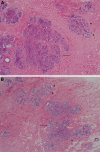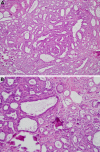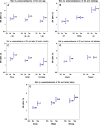Sclerosing adenosis and risk of breast cancer
- PMID: 24510013
- PMCID: PMC3924024
- DOI: 10.1007/s10549-014-2862-5
Sclerosing adenosis and risk of breast cancer
Abstract
Over one million American women have a benign breast biopsy annually. Sclerosing adenosis (SA) is a common, but poorly understood benign breast lesion demonstrating increased numbers of distorted lobules accompanied by stromal fibrosis. Few studies of its association with breast cancer have been conducted, with contradictory results. We studied SA in the Mayo Benign Breast Disease (BBD) Cohort, which includes women who had benign biopsies at Mayo-Rochester 1967-2001. Breast cancer risk in defined subsets was assessed using standardized incidence ratios (SIRs), relative to the Iowa Surveillance, Epidemiology, and End Results registry. This BBD cohort of 13,434 women was followed for a median of 15.7 years. SA was present in 3,733 women (27.8 %) who demonstrated an SIR for breast cancer of 2.10 (95 % CI 1.91-2.30) versus an SIR of 1.52 (95 % CI 1.42-1.63) for the 9,701 women without SA. SA was present in 62.4 % of biopsies with proliferative disease without atypia and 55.1 % of biopsies with atypical hyperplasia. The presence of SA stratified risk in subsets of women defined by age, involution status, and family history. However, SA does not further stratify risk in women diagnosed with other forms of proliferative breast disease, either with or without atypia. SA is a common proliferative lesion of the breast which, as a single feature, conveys an approximate doubling of breast cancer risk. Its role in breast carcinogenesis remains undefined; its presence may aid in risk prediction for women after a breast biopsy.
Figures



Similar articles
-
Invasive breast cancer risk in women with sclerosing adenosis.Cancer. 1989 Nov 15;64(10):1977-83. doi: 10.1002/1097-0142(19891115)64:10<1977::aid-cncr2820641002>3.0.co;2-n. Cancer. 1989. PMID: 2804888
-
Complex fibroadenoma and breast cancer risk: a Mayo Clinic Benign Breast Disease Cohort Study.Breast Cancer Res Treat. 2015 Sep;153(2):397-405. doi: 10.1007/s10549-015-3535-8. Epub 2015 Aug 12. Breast Cancer Res Treat. 2015. PMID: 26264469 Free PMC article.
-
NanoString-based breast cancer risk prediction for women with sclerosing adenosis.Breast Cancer Res Treat. 2017 Nov;166(2):641-650. doi: 10.1007/s10549-017-4441-z. Epub 2017 Aug 10. Breast Cancer Res Treat. 2017. PMID: 28798985 Free PMC article.
-
Epidemiology and endocrinology of benign breast disease.Breast Cancer Res Treat. 1985;6(1):5-36. doi: 10.1007/BF01806008. Breast Cancer Res Treat. 1985. PMID: 3902125 Review.
-
[Benign proliferative breast disease with and without atypia].J Gynecol Obstet Biol Reprod (Paris). 2015 Dec;44(10):980-95. doi: 10.1016/j.jgyn.2015.09.037. Epub 2015 Nov 3. J Gynecol Obstet Biol Reprod (Paris). 2015. PMID: 26545856 Review. French.
Cited by
-
Sclerosing adenosis: Ultrasonographic and mammographic findings and correlation with histopathology.Mol Clin Oncol. 2017 Feb;6(2):157-162. doi: 10.3892/mco.2016.1108. Epub 2016 Dec 13. Mol Clin Oncol. 2017. PMID: 28357084 Free PMC article.
-
Evaluation of 2 breast cancer risk models in a benign breast disease cohort.Cancer. 2018 Aug;124(16):3319-3328. doi: 10.1002/cncr.31528. Epub 2018 Jun 22. Cancer. 2018. PMID: 29932456 Free PMC article.
-
Ki-67 expression in sclerosing adenosis and adjacent normal breast terminal ductal lobular units: a nested case-control study from the Mayo Benign Breast Disease Cohort.Breast Cancer Res Treat. 2015 May;151(1):89-97. doi: 10.1007/s10549-015-3370-y. Epub 2015 Apr 12. Breast Cancer Res Treat. 2015. PMID: 25863475 Free PMC article.
-
Sclerosing adenosis of the breast: report of two cases and review of the literature.Pol J Radiol. 2015 Mar 7;80:122-7. doi: 10.12659/PJR.892706. eCollection 2015. Pol J Radiol. 2015. PMID: 25806097 Free PMC article.
-
Breast Sclerosing Adenosis and Accompanying Malignancies: A Clinicopathological and Imaging Study in a Chinese Population.Medicine (Baltimore). 2015 Dec;94(49):e2298. doi: 10.1097/MD.0000000000002298. Medicine (Baltimore). 2015. PMID: 26656378 Free PMC article.
References
Publication types
MeSH terms
Grants and funding
LinkOut - more resources
Full Text Sources
Other Literature Sources
Medical

